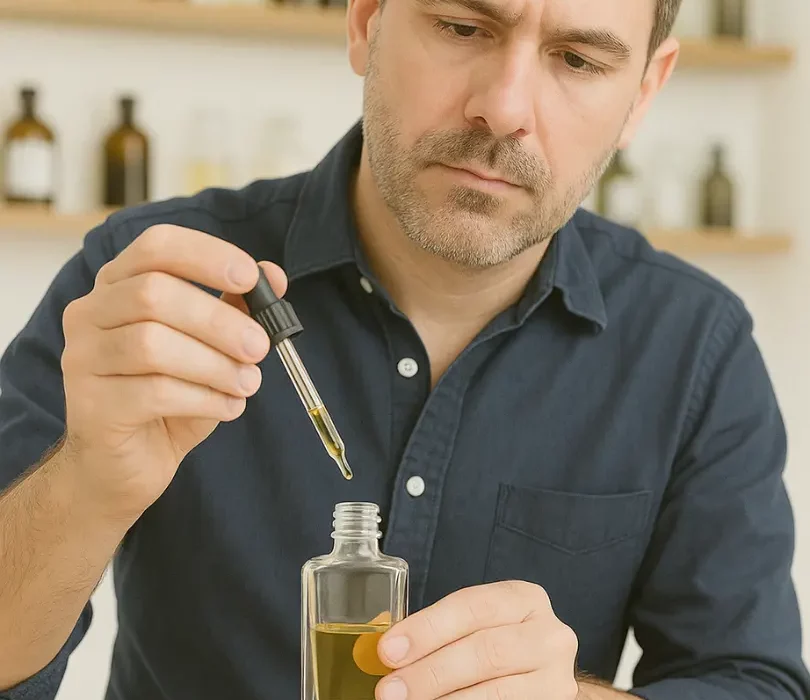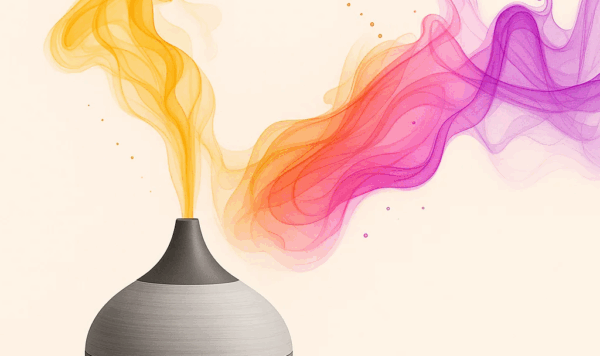The Art of Olfactory Creation
Creating a home fragrance is not merely a technical process—it is an art form that blends inspiration, culture, expertise, and sensitivity. At the heart of this artistry is the “nose,” or perfumer: a professional and creative figure who transforms abstract ideas into concrete aromas capable of evoking memories, emotions, and atmospheres.
The creative process begins with an idea, a theme, a suggestion. It always starts with a question: what feeling should this fragrance convey? Relaxation, intimacy, energy, purity? This answer guides the entire journey. The nose imagines an olfactory path and builds it starting from the top notes, often citrusy or green, which provide the initial impact. These are followed by the heart notes—floral, spicy, or aromatic—which carry the emotional message of the fragrance. Finally, the base notes—woody, amber, or musky—anchor the scent in the air and the memory.
Every home fragrance is like a symphony: harmony, intensity, and persistence must coexist. The nose works with small variations, testing hundreds of combinations, always in search of the perfect balance. It is a slow process, full of trials, errors, intuition, and patience.
Home fragrances in particular must ensure uniform diffusion, long-lasting hold, and a coherent evolution. They must wrap the space without overwhelming it, becoming part of the domestic identity.
Ultimately, what the perfumer creates is a true sensorial experience, transforming a physical space into an emotional refuge. Fragrance is not just something you smell—it’s something you live.
Selecting the Raw Materials
At the heart of home fragrance creation lies a fundamental phase: the selection of raw materials. Each scent is born from the meticulous choice of ingredients that, alone or in harmony, can create an evocative, long-lasting, and high-quality composition.
The olfactory world is divided into two major categories: natural and synthetic ingredients. The former include essential oils extracted from plants, flowers, fruits, resins, and spices. Iconic examples are lavender, cedarwood, patchouli, lemon, and bergamot. These ingredients offer authenticity and benefits linked to aromatherapy and wellness. Natural notes carry stories and traditions, making each home fragrance more intimate and personal.
Synthetic ingredients should not be demonized—they allow perfumers to explore new olfactory dimensions, often impossible to achieve in nature, and they provide greater stability and longevity. Moreover, they are essential for replicating complex accords or reducing exposure to overly aggressive natural allergens.
Selection is based on rigorous criteria: purity, sustainability, traceability, and the ability to interact with other raw materials. Brands like Oniusa Venezia that aim for excellence choose certified suppliers, inspect each batch, and test every component not only for its olfactory impact but also for safety in indoor environments.
Creating home fragrances therefore requires a scientific, ethical, and creative approach. To achieve the perfect blend, each raw material is measured and mixed with attention to its intensity, evolution over time, and its ability to harmonize within a space.
The Composition Process
Once the nose has gathered all the selected raw materials, the real magic begins: the composition of the fragrance. This is where creativity meets chemical precision, and every ingredient finds its place in the olfactory pyramid.
It begins with constructing the formula, where each note is measured down to the milligram. Even a tiny variation can alter the final result. The goal is harmony, balance, and originality—every home fragrance must be recognizable, coherent, and memorable.
Composition takes place in the lab. Perfumers use highly precise instruments to mix essences, though their most important “tool” remains their nose. The blend is then left to mature in specific containers. This resting period can vary from two weeks to several months, depending on the complexity of the fragrance. It is a crucial phase, allowing the molecules to meld, stabilize, and gain depth.
Once maturation is complete, the fragrance is filtered and subjected to a new series of olfactory tests. This includes real-world trials on blotter papers, reeds, spray bottles, and diffusers. The fragrance must perform consistently across all intended applications.
When the nose gives final approval, the fragrance receives its olfactory signature—a scent that embraces the space not just to decorate it, but to welcome you into it. The transition from formula to final product is a ritual of precision, beauty, and sensitivity, confirming once again that home fragrances are invisible but powerful masterpieces.
Testing and Optimization of the Fragrance
Before launching a new home fragrance, it is essential to subject it to rigorous testing to ensure product quality and safety. These tests assess the fragrance’s stability over time, its compatibility with diffuser materials, and its overall performance in domestic environments.
Olfactory tests involve panels of experts and consumers who evaluate the fragrance under various conditions. The feedback collected is crucial for making any necessary adjustments to the composition, enhancing the sensory experience, and meeting customer expectations.
In addition, safety tests are carried out to ensure the fragrance does not cause allergic reactions or skin irritation. Only after passing all these checks is the fragrance ready to be marketed, offering consumers a high-quality, safe-to-use daily product.
Packaging Design
The packaging of home fragrances plays a crucial role in the customer experience. Beyond protecting the product, the design communicates the brand’s identity and the essence of the fragrance. High-quality materials, elegant shapes, and refined details help create a product that doubles as a home décor element.
The design process begins with defining a visual concept that aligns with the fragrance and its target audience. Colors, materials, and finishes are chosen to reflect the olfactory sensations. For instance, a fresh, citrusy fragrance may be presented in a transparent bottle with bright accents, while a warm, woody scent might feature a dark glass container with gold or wooden elements to convey elegance and depth.
The packaging of home fragrances must be not only visually appealing but also functional. It should protect the scent composition from light, air, and humidity to preserve its quality. The diffusion method is also carefully selected: porous wooden sticks, sprays, atomizers, or bottles for burners.
In the case of Oniusa Venezia, each package is designed as an integral part of a daily ritual: the cap, the glass color, and the label’s texture all contribute to a complete sensory experience that engages not only smell but also sight and touch.
Finally, great attention is paid to packaging sustainability. More and more brands are choosing recyclable materials, reducing plastic usage, and adopting minimal, eco-friendly designs, in line with the values of increasingly conscious consumers.
The Artisanal Nature of Oniusa Venezia
The heart of Oniusa Venezia’s home fragrance creation lies in craftsmanship. Each product is born in Italian laboratories where perfume-making tradition blends with innovation. The process is manual, done in small batches, with meticulous attention to every detail.
The journey begins with deep olfactory research: inspirations drawn from Venice—its gardens, spices, hidden courtyards. From these ideas, exclusive blends are developed that tell a story. Handcraftsmanship plays a role in both blending and packaging: labeling, inserting sticks, and sealing are all done with care and dedication.
This approach makes Oniusa home fragrances authentic and unique. Each piece has its own personality, unreplicable on an industrial scale. Even the bottles, often numbered or personalized, reflect artisanal exclusivity.
Craftsmanship is not only an aesthetic or technical choice—it is a philosophy. It means respecting the time required for a fragrance to mature, honoring raw materials and the customer who receives a product made with love. Choosing Oniusa Venezia means supporting Italian excellence that places quality at the center of every action.
Conclusion
A home fragrance is much more than a scent. It’s a creative journey that begins with an intuition and evolves through expert hands, fine materials, and rigorous testing. Behind every bottle, reed, or mist of essence lies a story of passion, knowledge, and inspiration.
When we choose a room fragrance, we are choosing the emotion we want to live in our home. Relaxation, energy, focus, intimacy—each note guides and accompanies us. With Oniusa Venezia, this sensory journey becomes one of beauty, authenticity, and art.
In a world of authenticity and care, Oniusa stands as a reference point: a brand that believes in quality, in respecting time, and in the subtle beauty of small daily gestures.
Discover the artisanal fragrances by Oniusa Venezia and transform your home into a unique sensory experience – oniusavenezia.com
FAQ – Frequently Asked Questions about Oniusa Venezia Home Fragrances
How is a home fragrance created?
The creation of a home fragrance begins with a well-defined olfactory idea. The perfumer selects natural or synthetic raw materials and combines them following the olfactory pyramid (top, heart, and base notes). After several trials and a maturation phase, a balanced fragrance is born, ready to be used in diffusers, sprays, or candles.
What are the best room fragrances for relaxation?
Ideal room fragrances for relaxation include notes of lavender, chamomile, sandalwood, and vanilla. These scents foster a calm atmosphere—perfect for evening hours or dedicated relaxation spaces.
How long does a room fragrance last?
The longevity of a room fragrance depends on the type of diffuser, the concentration of the formula, and the room’s ventilation. On average, a quality reed diffuser can last between 4 to 8 weeks.
Can home fragrances affect mood?
Yes, many home fragrances are specifically designed to evoke particular feelings: relaxation, energy, focus. Thanks to aromatherapy, certain scents can act on the limbic system and influence mental and emotional well-being.
Does Oniusa Venezia use natural ingredients?
Yes, Oniusa Venezia places great emphasis on the quality of raw materials. The use of natural ingredients, essential oils, and artisanal techniques is central to the brand’s philosophy, combining Venetian tradition with olfactory innovation.






